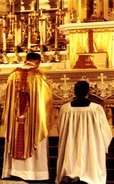Taken from Shouts in the Piazza
The commemoration of all the faithful departed is celebrated by the Church on 2 November, or, if this be a Sunday or a solemnity, on 3 November. The theological basis for the feast is the doctrine that the souls which, on departing from the body, are not perfectly cleansed from venial sins, or have not fully atoned for past transgressions, are debarred from the Beatific Vision, and that the faithful on earth can help them by prayers, almsdeeds and especially by the sacrifice of the Mass.
In the early days of Christianity the names of the departed brethren were entered in the diptychs. Later, in the sixth century, it was customary in Benedictine monasteries to hold a commemoration of the deceased members at Whitsuntide. In Spain there was such a day on Saturday before Sexagesima or before Pentecost, at the time of St. Isidore (d. 636). In Germany there existed a time-honoured ceremony of praying to the dead on 1 October. This was accepted and sanctified by the Church. St. Odilo of Cluny (d. 1048) ordered the commemoration of all the faithful departed to he held annually in the monasteries of his congregation. Thence it spread among the other congregations of the Benedictines and among the Carthusians and eventually to the whole Church.
In Spain, Portugal, and the Americas, priests on this day say three Masses. Black or Violet vestments (no...black vestments were not abolished...they are still optional for funerals in the United States) are worn as a sign of mourning. It is customary to visit cemeteries on this day.
Subscribe to:
Post Comments (Atom)



No comments:
Post a Comment